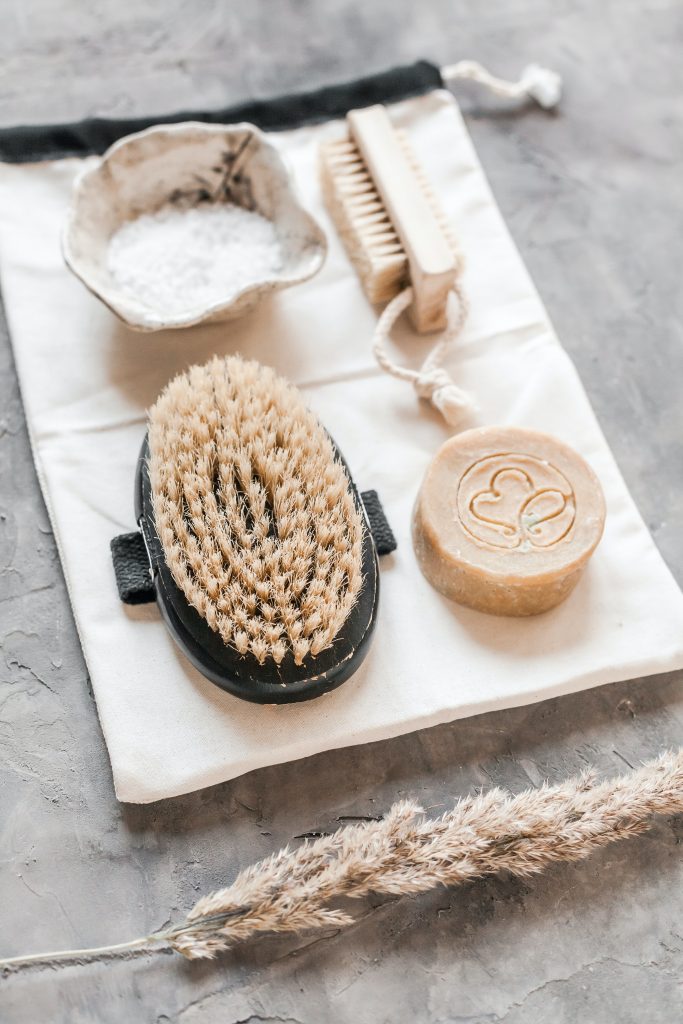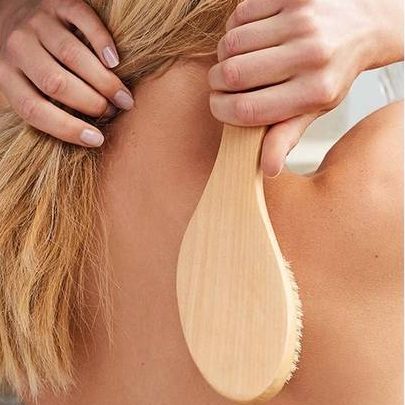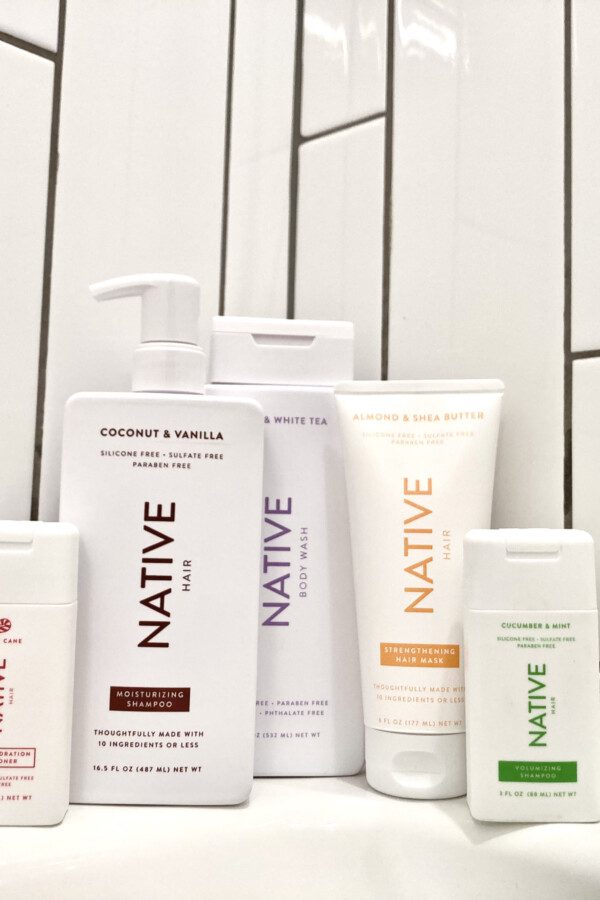You’ve likely heard the rumors about the numerous benefits of dry brushing… but does it actually work? In this article, we’re going to look at the origins, the myths and benefits, how to choose a dry brush, and how to do it properly.
Table of Contents
- What Is Dry Brushing?
- What Are The Benefits Of Dry Brushing?
- Dry Brushing Exfoliates Dead Skin Cells
- Dry Brushing Unclogs Pores and Cleans Skin
- Increase Circulation with Skin Brushing
- What Are Some of the Myths with Dry Brushing?
- Can Dry Brushing Help With Cellulite?
- Does Dry Brushing Increase Collagen Production?
- Does Dry Brushing Help Stretch Marks?
- Will Dry Brushing Help With Spider Veins?
- Dry Brushing Stimulates and Energizes… or Relaxes!
- Does Dry Brushing Help Detox and Remove Toxins?
- Are There Any Risks for Dry Brushing?
- Is Dry Body Brushing Safe For Everyone?
- What Are the Proper Dry Brushing Techniques? [How To Dry Brush Your Skin]
- What Should You Do After Dry Brushing?
- Do I Have To Shower After Dry Brushing?
- How Often Do You Dry Brush Your Body?
- Can You Dry Brush Your Face?
- How To Choose The Best Dry Body Brush
- Dry Brush For Face
- Or Try Dry Brushing Gloves, a.k.a. Exfoliating Gloves!
- What is an Ionic Dry Body Brush?
- Conclusion: Does Dry Brushing Really Work?
This post contains affiliate links, which means we may earn a small commission if you choose to make a purchase. We only make recommendations that are genuine and meet our ingredient/material safety standards.
What Is Dry Brushing?
Dry brushing is a particular way of brushing your (dry) skin with a (dry) brush—like this one. It has a lot of potential benefits, including exfoliation, lymphatic support (a.k.a detoxification), decreased cellulite, unclogging pores, and even stress relief.
And the best part is: it’s cheap and only takes a few minutes.
The History of Dry Brushing: Ayurveda & Beyond
The practice of dry brushing goes back thousands of years.
Some of the roots of dry brushing can be found in Ayurvedic medicine. Ayurveda, which in Sanskrit means “The Science of Life,” is “considered by many scholars to be the oldest healing science.” It originated more than five millennia ago in India, has been passed down over generations, and is still widely used all over the world today.
Much the Ayurvedic approach consists of balance and prevention. Many people in the West consider Ayurveda and other “alternative” and “holistic” approaches to be in contrast or conflict with conventional Western medicine; however, they can actually work very well in tandem with one another! Systems like Ayurveda can be very effective at helping people maintain holistic health over their lifetime in order to prevent disease (something Western medicine is terrible at). And conventional Western medical systems are great at treating acute disease and illness.
Traditional Ayurvedic dry brushing is called garshana. In addition to using a thistled brush like we do today, practitioners would also use raw silk or linen to stimulate circulation and blood flow.
The Ancient Egyptians are also known to have dry brushing practices, and they would apparently complement the brushing with extra exfoliation by using sour milk and wine enzymes to further soften their skin.
Traditional Chinese cultures used dried leaves and plant fibers (what we know of now as a loofah) to stimulate circulation as well.
So, as you can see, dry brushing is nothing new—humans have been doing it for thousands of years!

What Are The Benefits Of Dry Brushing?
Dry brushing has several potential benefits, which include:
- Exfoliation
- Cleans skin
- Increases circulation
- Reduces the visibility of collagen, wrinkles, stretch marks, and spider veins
- Lymphatic support and detoxification
- Energizes and/or relaxes
Some of these benefits are more obvious, whereas the efficacy of others come with some debate. Let’s first look at the well-known benefits, and then we’ll move onto the more controversial ones.
Dry Brushing Exfoliates Dead Skin Cells
To “exfoliate” means “to remove the surface of” or “to throw off scales or flakes.” In short, exfoliating one’s skin means to take off that top layer of dead skin cells, allowing the layer underneath to breathe and better absorb the oils and nutrients from your moisturizer. It also just leaves the skin feeling soft and fresh.
Active exfoliation becomes more important as we get older as our skin loses its ability to automatically renew itself as easily. This is the most immediate and obvious difference you will notice from dry brushing, even after just doing it once. It really does leave your skin feeling smoother in just a few minutes.
This is especially a good idea during the winter months when you might have an excess of dry skin from the cold.
Dry Brushing Unclogs Pores and Cleans Skin
Unclogging your pores goes along with exfoliation. When dead skin cells, oil, dirt, lotions, and pollutants from the environment stay on our skin, our pores get clogged, which can cause things like blackheads, acne, and ingrown hairs. Unclogging pores may also help our skin absorb more nutrients and detox more efficiently as well (more on that below).
Increase Circulation with Skin Brushing
Stimulating your skin with the dry bristles helps to “wake up” the sluggish lymph and blood that lies right beneath the skin’s surface. This circulation essentially causes a waterfall effect, leading to other benefits like increased energy and detoxification.

What Are Some of the Myths with Dry Brushing?
Now, let’s look at some of the other benefits (or potential benefits?) of dry brushing.
The following benefits of dry brushing are largely anecdotal and have little to no scientific evidence to back them up. However, remember that just because something hasn’t been studied doesn’t mean it’s automatically bogus.
At the end of the day, we just don’t know for sure at this time whether the below benefits of dry brushing are truly effective, or if they are just myths.
But the good news is that (with a few exceptions, which we’ll address below), dry brushing is a safe, cheap, fast, and accessible self-care practice. So even if these dry brushing benefits turn out to lack efficacy, there’s really no harm done either.
Can Dry Brushing Help With Cellulite?
Although many people claim that dry brushing can help reduce cellulite, there is no scientific evidence to support that so far.
Instead, it could just be that the plumping of the skin that comes from increased blood circulation reduces the appearance of cellulite temporarily. (Massage has been shown to temporarily reduce the appearance of cellulite, so one might deduce that dry brushing could have similar effects.)
Does Dry Brushing Increase Collagen Production?
Collagen is a type of protein that keeps your skin, bones, and joints looking and feeling strong and healthy. Our bodies make collagen as part of a natural process, but there are certain things you can do to boost collagen in your body (like getting a full night of sleep or taking a high-quality collagen supplement).
Dry brushing could be another one of those things. Although, this is another one that just doesn’t yet have the research to back it up.
Does Dry Brushing Help Stretch Marks?
Stretch marks occur during periods of rapid growth (such as pregnancy, weight gain, or building of muscle mass) when the collagen bundles underneath your skin separate and tear away from each other.
Many people anecdotally claim that dry brushing can help prevent and/or decrease the look of stretch marks as well. Again, there is no scientific evidence support this claim either.
However, dry brushing CAN help to get rid of dead skin cells that might be getting in the way of oils and lotions that can help reduce the appearance of stretch marks (like this one). So one could make the argument that dry brushing does help with stretch marks in a roundabout way.
Will Dry Brushing Help With Spider Veins?
You might hear some say that dry brushing will help with spider veins, or varicose veins. But alas, there is no evidence to support this one either. Older individuals with thinner and less elastic skin should be careful to dry brush lightly in order to prevent micro-tears and scratches on those veins that could potentially cause infection.
Dry Brushing Stimulates and Energizes… or Relaxes!
An interesting thing about dry brushing anecdotes is how some people say it energizes them while others say it makes them feel calmer and more relaxed.
Because dry brushing stimulates your skin and increases circulation, it could make you feel energized. On the other hand, dry brushing is kind of like a massage, so it could leave you feeling relaxed. You might want to try it out and see how it affects your energy levels, and then decide whether it would be better for you to dry brush in the morning or evening.

Does Dry Brushing Help Detox and Remove Toxins?
You may have also heard that dry brushing helps to detoxify the body and remove toxins by stimulating the lymphatic system. This is another one that’s up for debate.
Dry Brushing for The Lymphatic System
The lymphatic system is essentially part of the body’s “drainage system,” and it’s a very important part of your immune system. It consists of a system of organs, blood vessels, and lymph nodes that transport lymph throughout the body. (You know those two nodes on the side of your neck that sometimes get swollen and sore? Those are lymph nodes. Most of the time, when those get sore, it means your immune system is working to fight something off.)
Many of these lymph vessels lie just below the skin, so dry brushing proponents claim that regular dry brushing can help stimulate lymphatic movement and encourage your body’s natural detoxification systems to keep moving.
While this could definitely be the case, more research needs to be done to know for sure. Some say that since dry brushing only really affects the uppermost layers of the skin, it can’t reach deep enough to really affect the lymphatic system.
If you want a more guaranteed way of stimulating your body’s lymphatic system to support detoxification (that is still cheap and easy!), you can try doing a lymphatic massage on yourself.
Are There Any Risks for Dry Brushing?
For those with “normal” skin, dry brushing is perfectly safe. It can be a great way to slow down, exfoliate your skin, and take a few minutes for some mindful self care.
But there are some people who shouldn’t dry brush (or do so very carefully and with the approval of your dermatologist).
Can I Dry Brush If I Have Sensitive Skin?
If you have sensitive skin, dry brushing might be more irritating than beneficial. Be sure to talk to your dermatologist if you’re unsure.
Is Dry Body Brushing Safe For Everyone?
If you have certain skin conditions like eczema or psoriasis, if you have opened wounds or actively inflamed skin, dry brushing might not be safe for you. Not only could you further irritate the skin, but you could also brush bacteria into your opened skin, causing infection.

What Are the Proper Dry Brushing Techniques? [How To Dry Brush Your Skin]
So, now that you know about the benefits of dry brushing (both confirmed and potential), here is how to do it right:
- Choose your dry brush. (See below for how to do that.)
- You don’t have to, but it’s best to stand in the shower with the water off and without any clothes so that any dead skin can be easily washed away.
- Do not wet yourself or the brush. It’s called dry brushing for a reason! Wet brushing doesn’t have the same exfoliating benefits, and brushing your skin in hot water can strip your skin of beneficial oils.
- Start at the bottom of your feet and move upward, making long, sweeping strokes toward the heart. You want to always stroke toward the chest area, where the lymph drains; doing the opposite might put extra pressure on the valves within the veins and vessels, causing varicose veins or ruptured vessels.
- Start with each leg, then repeat the process with your hands and arms.
- On the stomach, back, and armpits, brush in a circular, clockwise motion.
- Brush each area several times, being careful especially at first to test how sensitive you are to it. Certain parts of your body may be more sensitive than others.
- Don’t go overboard. Exfoliating the skin too much can actually dehydrate your skin, and you don’t want to do that! Your skin might be a little pink when you’re finished because of the increased blood flow, but it should never be red or severely irritated. And you should definitely not ever brush so hard that you break the skin.
- After you’ve dry brushed your entire body, shower as you normally would and use a non-toxic body lotion or oil afterward to moisturize.
- The total time should take anywhere from 5 to 10 minutes.
What Should You Do After Dry Brushing?
After you shower and moisturize, remember to clean your brush with non-toxic soap and water at least once a week. Let your brush air dry to prevent any mildew or skin cell buildup. You also will need to replace your brush every so often (depending on how often you use it) because the bristles will eventually wear down, decreasing the benefits.
Do I Have To Shower After Dry Brushing?
No, you don’t HAVE to shower after dry brushing, but it is better to so so that you can be sure to rinse off all that loosened dead skin.
How Often Do You Dry Brush Your Body?
If you don’t have sensitive skin, you can dry brush as often as you’d like, even daily. To experience the ongoing benefits of dry brushing, it’s recommended that you dry brush weekly at a minimum. Just make sure you’re paying attention to your body and that if you have any negative side effects like irritation or a lot of redness, you either stop, decrease your frequency, or lighten up on the pressure a bit.

Can You Dry Brush Your Face?
Yes! You can dry brush your face just like you brush your body, and it can have a lot of the same benefits.
Face Brushing Benefits
Dry brushing your face can help with:
- Exfoliation
- Clearing pores and preventing acne, blackheads, and ingrown hairs
- Wrinkle reduction (maybe… Since dry brushing increases circulation, it might reduce the appearance of wrinkles temporarily, but probably won’t largely affect wrinkles in the long run.)
How to Dry Brush Your Face Properly
- To start, make sure your face and brush are both clean.
- Start at the top (on your forehead) and work your way down toward your heart with long brush strokes. Apply gentle pressure.
- Wash your face immediately after in order to get rid of dead skin cells and dirt that you loosened with your dry brush.
- Moisturize!
How Often Should You Dry Brush Your Face?
We recommend you start with once per week and see how your face feels and if you experience any irritation or sensitivity to the dry brushing. Then you can work your way up to three times per week if you want!
How To Choose The Best Dry Body Brush
When choosing a dry brush, make sure you go natural. You don’t want to be brushing your body with plastics and synthetics, which could be toxic and therefore defeat the purpose! Look for materials like bamboo, wood, sisal, jute, and boar bristle.
When choosing your size, it’s totally based on your preference. You may want to get a brush with a long handle so that you can more easily reach your back, legs, etc. Or, you may want to get a smaller, hand-held one with a strap for more precision. Or even better, this one has a detachable head so you can use it either with or without the long handle!



Dry Brush For Face
Although you can use one of the handheld dry brushes above for your face, many people prefer to use a smaller one like this one.

Or Try Dry Brushing Gloves, a.k.a. Exfoliating Gloves!
If you want to skip the brush altogether, you can try out exfoliating gloves, which basically do the same thing, but are easier to use for some. Try these ones from Earth Therapeutics.
What is an Ionic Dry Body Brush?
An ionic dry brush, also called a Prana Brush, is a dry brush that’s infused with copper bristles. Rooted in Ayurveda, the copper bristles contain “extra-fine ion-charged copper bristles, which naturally create negative ions that protect your body from free radicals and have numerous other health benefits.” Check it out for yourself to see if you notice a difference.
Conclusion: Does Dry Brushing Really Work?
Some of the benefits of dry brushing (like exfoliation) are clear and quick to see. Other benefits are more anecdotal and more research still needs to be done to find out if dry brushing actually works. Regardless, dry brushing can be a great way to slow down and give yourself some mindful self-care while softening your skin. And with a few exceptions (like those with psoriasis for example), it’s completely safe!
Do you like to dry brush as a part of your routine? Let us know what kind of benefits you experience.
PIN IT:










